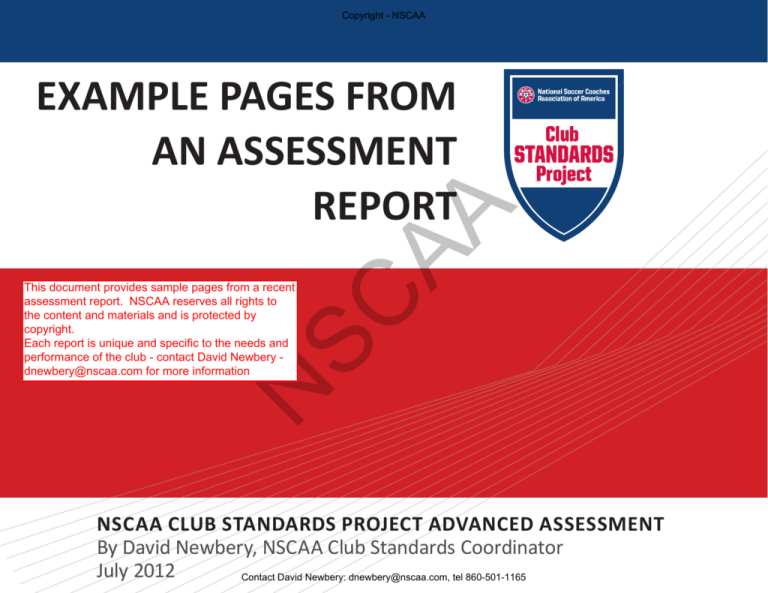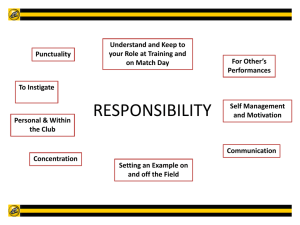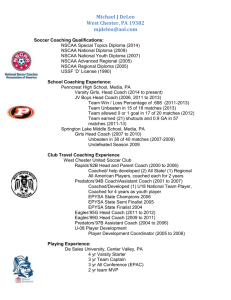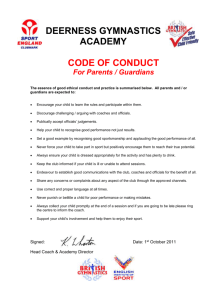
Copyright - NSCAA
N
SC
This document provides sample pages from a recent
assessment report. NSCAA reserves all rights to
the content and materials and is protected by
copyright.
Each report is unique and specific to the needs and
performance of the club - contact David Newbery dnewbery@nscaa.com for more information
AA
EXAMPLE PAGES FROM
AN ASSESSMENT
REPORT
NSCAA CLUB STANDARDS PROJECT ADVANCED ASSESSMENT
By David Newbery, NSCAA Club Standards Coordinator
July 2012
Contact David Newbery: dnewbery@nscaa.com, tel 860-501-1165
AUTHOR
AA
Copyright - NSCAA
SC
David Newbery, Coordinator, NSCAA Club Standards Project
For over 20 years David has studied and worked in youth education, soccer development and coaching.
A former University Professor and CEO of a Youth Sports Company, David has been fortunate to travel
extensively in the USA, meeting with coaches and club officials and learning about their approach
to player development and coaching. Experiences from hundreds of clubs has afforded him the
opportunity to support and guide youth soccer organizations, endeavoring to develop an educationally
sound environment for players, coaches and parents.
N
David developed the club assessment process in 2008 called the Youth Soccer Assessment Tool (Y-SAT)
and was appointed to lead the NSCAA Club Standards Project in January 2012. David and former
USA Women’s National Team Coach, Tony DiCicco, are partners in a soccer consultation business,
SoccerPlus FC, supporting volunteer based youth programs to become more serious about player and
coach development. David contributes articles regularly to soccer publications, has written books
focusing on player and coach development and presents at national soccer events. In his spare time,
David operates a youth soccer program for players age 3 to 8 in Stonington, CT.
Copyright © 2012 by National Soccer Coaches Association of America, All rights reserved.
Author & Editor: David Newbery, NSCAA Club Standards Project Coordinator
Published by National Soccer Coaches Association of America, 800 Ann Ave, Kansas City, KS 66101.
No part of this work may be reproduced or transmitted in any form, for commercial
purposes or by any means electronic or mechanical, including photocopying or recording
Contact David Newbery: dnewbery@nscaa.com, tel 860-501-1165
01
Copyright - NSCAA
NSCAA CLUB STANDARDS PROJECT
Elevating the standard of player and coach development in the USA, one organization at a time
5-6
INTRODUCTION
EXECUTIVE SUMMARY
PLAYER DEVELOPMENT
Letter to the Club XXXXX outlining the scope of
An overview of the key findings and
In-depth review of the organizations current
the report
recommendations
performance in Player Development,
SC
N
31-45
7-30
AA
2-4
conclusions, scores and recommendations
46-58
59-64
COACHING
ADMINISTRATION
CONCLUSIONS
In-depth review of the organizations current
In-depth review of the organizations current
Final remarks and the official designation
performance in coaching, conclusions, scores
performance in Administration, conclusions,
awarded to the organization by the NSCAA
and recommendations
scores and recommendations
Each section of the report follows a similar structure - 1) Introductory to the focus area; 2) Strengths analysis; 3) Weakness
analysis; 4) Scores and NSCAA designation; 5) Recommendations
Contact David Newbery: dnewbery@nscaa.com, tel 860-501-1165
NSCAA ADVANCED ASSESSMENT
Copyright - NSCAA
Club XXXXX’S Current Performance in
07
N
SC
AA
PLAYER DEVELOPMENT
The term player development is used indiscriminately in youth soccer to suggest a more modern approach to education. However, player development should be, in
our opinion, the key philosophy and main principle guiding the approach for all decisions made on and off field. Player development is an education model designed
to enhance the performance of young players. The model considers the cognitive, emotional, physical and psychological readiness and maturity of an individual and
provides a pathway to manage the athlete’s progress between stages of development. A player development model treats fun and learning as mutually inclusive
outcomes of participation and provides the very best opportunity for an individual to succeed and maintain their interest and commitment to the game.
Contact David Newbery: dnewbery@nscaa.com, tel 860-501-1165
NSCAA ADVANCED ASSESSMENT
Copyright - NSCAA
PLAYER DEVELOPMENT STRENGTHS
10
NSCAA GOOD PRACTICE EXAMPLE
participation numbers are very impressive at the Pre Kindergarten through 6th grade age groups, enabling the
Player
organization to implement numerous programming options.
Establishing a large base of players at the early stages of development is crucial to future success and longevity of a youth soccer program.
Reports from Spring 2012 suggest xxxx players were registered in the Recreation and Competitive Programs from Pre Kindergarten to 6th
grades. Certainly Club XXXXX performs better than most assessed youth programs. Interestingly participation increased steadily in each age
group from Pre K to 2nd grade, with over 800 players registered in the recreation and competitive 2nd grade programs.
stated on the organization’s website.
2. The player development approach
Club XXXXX Board. Formed in 2012, the
advisory board has 9 members mostly
consisting of parents with children in
the program or have graduated the
program.
SC
Approach, Philosophy and Education
Model
1. The player development philosophy is
AA
Healthy participation numbers provides exciting opportunities to introduce a wide range of new initiatives, programs and events. For
example, a significant player pool allows for more focused individual development and programs such as specialized position training, ability
based groupings and ‘Academy’ type events. Other benefits such as the capacity to operate an in-house league (without significant travel
requirements) and the flexibility to create the club’s rules are essential for player development. Additionally, a more diverse program offering
can result in more registration ‘events’ and more revenue that can be used to fund increased support, training and oversight of the coaches.
Curriculum and Resources
6. The Club XXXXX has created a number
is taught to coaches at the annual/
seasonal training event.
of coaching manuals for Recreation
and Club XXXXX programs, including,
Kindergarten Rules, Town XXXXX Soccer
Player Development Handbook, Micro
Soccer Handbook, Club XXXXX Coaches
Manual and Youth Sports Coaches
Manual. In the most part, these
documents are appropriate, informative
and logically presented. There are
sections relating to the philosophies,
behavioral characteristics of the children
and great tips for new and experienced
coaches alike.
3. The Director of Coaching and Club
N
XXXXX Advisory Board offer advice and
opinions on the player development
philosophy and approach
Organization
4. All players in the program wear a soccer
uniform. At the Micro and Recreation
levels this consists of a jersey and in
the Club XXXXX the teams can decide
on a choice of colored shirts, shorts
and socks. The uniform is a mark of
unity, identity, and provides a sense of
belonging.
5. Participation in the State competitive
7. Some practice plans are available to
leagues required Club XXXXX to form the
coaches on the Club XXXXX section of
the website and feature a number of
topics including ball control, passing and
shooting.
8. The organization also provides other
coaching related articles on the website
on topics such as nutrition, injuries and
behavioral characteristics of players.
9. Emphasis in the coaching manuals to
fun, enjoyment and education is well
balanced.
Programming
10. The organization has adopted a small
sided game format for recreation age
groups.
11. Club XXXXX provides recreation and
travel soccer programs for players
4 to 18 years of age. This offers the
organization with an opportunity
to seamlessly implement the
complete ‘continuum’ of youth player
development.
The strengths are a list of key observations/facts that will inform the recommendations and scoring. Typical reports have 15-30
strengths identified
Contact David Newbery: dnewbery@nscaa.com, tel 860-501-1165
NSCAA ADVANCED ASSESSMENT
Copyright - NSCAA
PLAYER DEVELOPMENT WEAKNESSES
Approach, Philosophy and Education
Model
1. The organization’s literature refers to
(bullet #1), there is little evidence to
suggest a commonly held approach to
player development exists.
3. As previously mentioned as a strength,
7. On several occasions parents, coaches,
Board Members and Administrators
referred to a conflict between offering a
community based program founded on
the Club values and providing a program
providing opportunities for committed
and talented players. One can certainly
imagine scenarios where greater
emphasis on competition and winning
can lead to player exclusion, poor player
and coach behavior and conflict. These
are expected outcomes of a poorly
administered and conceived program
and badly educated coaches. However,
the benefits to the community, coaches
and administrators of adopting an
educational sound approach and model
of player development will result in the
Club XXXXX addressing current issues of
equality and opportunity (this point is
discussed more fully in the next section).
Organization
8. Undoubtedly it is a considerable task
to organize a program the size of
Club XXXXX. With that said however,
there are instances where operational
considerations go before the best
interests of player development. For
example:
N
several well conceived education
resources exist for the committed
and educationally motivated coach.
However, no true education framework
exists (curriculum).
education approach are not written,
taught and disseminated.
4. The Club offers 3 programs for players
between the ages of 4 and 18 years
old, but there is no education plans
or systems in place to transition the
players from one program or stage of
development to the next.
5. Quite rightly, Club XXXXX emphasizes
the importance of fun and enjoyment,
but general observations of the Micro
and Recreation Programs during the
site visit suggest some coaches have
taken the adage of ‘let the game be the
•
Club XXXXX has two magnificent
field complexes and are locations
where many coaching and player
development weaknesses could be
addressed. Opportunities to raise
coaching and player development
performance would be significantly
improved if the Club XXXXX
dedicated some field space at
Wright Park or Spirit Park for training
purposes and did not use these
facilities exclusively for games and
professional clinic training sessions.
Alternatively, player and coach
development would benefit from an
alternate location/s for training.
AA
2. With the previous concern in mind
6. Purposes, aims and outcomes of the
SC
a Player Development philosophy, but
there seems to be some inconsistencies
in approach and absence of a process
to ensure the approach is practically
applied by the parent coaches. For
example, the Player Development
Handbook quite rightly identifies
technical development, ball mastery,
repetition and reinforcement of
fundamental skills and stages of
development as critical variables/
considerations … but, observations
and interviews conducted during
the site visit indicate few coaches
are referencing these materials and
even fewer are employing the stated
approach.
teacher’ literally - very little teaching is
taking place in game like activities.
12
•
The practice of initially grouping
Recreation players by residential
location, school and parent
requests may present convenience
benefits for parents, but it is one
factor in creating inequalities in
player experience – it is luck of the
draw whether the coach from that
location is competent.
9. Achieving equal opportunity is certainly
a difficult proposition for any youth
program. The Club XXXXX program is
best described as providing equal access
- all registered players are assigned to a
group for practice and games. But, there
are certain inequalities in opportunity
mainly resulting from the variance in
the coaching level, experience and
commitment of the parent coach. This
issue is exacerbated in the Recreation
and Spirit Club programs where
recruitment of players by recreation
and Spirit Coaches to join ‘Coach select’
teams is widespread.
10. Retaining players in the program is
an equally as important measure of
organizational success as maintaining
large numbers. In this regard, Club
XXXXX experiences a significant drop
off in participation during the critical
decision making ages of 9-12 years
old. A 63% reduction in participation is
reported between 2nd and 6th grades.
Programming
11. A consistent finding from the on-site
interviews is a perception parents
Similar to the Strengths, the Weaknesses are a list of key observations/facts that will inform the recommendations and scoring.
Typical reports have 15-30 Weaknesses identified
Contact David Newbery: dnewbery@nscaa.com, tel 860-501-1165
NSCAA ADVANCED ASSESSMENT
Copyright - NSCAA
ADMINISTRATION SCORES
54
The table below presents the official NSCAA Club Standards Project assessment scores for Club XXXXX in
Administration. Based on strengths and weaknesses listed previously, a score is awarded in 10 sub categories. The
sub categories represent integral components of player development and are commonly associated with successful
youth programs. A simple 3 point scoring methodology is used: Bronze (1 pt) - indicates low levels of performance
and/or no significant evidence; Silver (2 pts) - indicates intermediate level of performance and/or some evidence; Gold
(3 pts) - indicates high level of performance and/or significant evidence.
ADMINISTRATION ASSESSMENT
AA
1
Strategic and Implementation Planning - Does the organization have a strategic plan? Is the organization
working towards short and long term objectives?, Has the organization balanced on and off field priorities? Are
player development factors driving decision making and thinking?
2
Mission, Vision and Values - Does the organization have a stated Mission, Vision and Values? Are
3
SC
members capable of articulating the Mission, Vision and Values? Does the organization periodically revisit
these statements? Does the organization invite member feedback about the general direction of the program?
Administrative Staffing - Is the number of administrative staff adequate to meet the needs of the
4
N
organization? Do the staff have the talent and time to meet the demands of the role? Do the administrators
receive ongoing support and training? Is there a continuity in staffing from one season to the next? Are the
administrative staff recruited to meet the demands of the tasks and role?
SCORE
SILVER
SILVER
GOLD
Administrative Function - Does the organization adopt replicable systems and administrative processes?
Does the organization provide the members a variety of contact options, including office hours, email,
online chat/forum etc? Is the organization able to operate several months ahead of programs needs? Does the
organization adequately manage the work flow and tasks to ensure timely response? Is the organization able to
respond to member requests within 24 hours of contact? Does the organization have detailed policies?
5
Volunteerism - Does the organization clearly state the volunteer policy? Is there a role on the Board or a
committee responsible for recruiting, managing and monitoring volunteers? Does the organization clearly
state the volunteer positions available? Does the organization actively pursue individuals with desired traits? Is the
organization attracting sufficient volunteers to meet the on and off field needs of the program?
GOLD
BRONZE
Each area of focus (Player Development, Coaching and Administration) is broken down into 10 sub categories for the purpose of
evaluation. Above are 5 of the Administrative Categories. Scores are Bronze (1pt), Silver (2pts) and Gold (3pts)
Contact David Newbery: dnewbery@nscaa.com, tel 860-501-1165
NSCAA ADVANCED ASSESSMENT
Copyright - NSCAA
ADMINISTRATION RECOMMENDATIONS
Plan for Club XXXXX
Soccer Programs
1Strategic
is particularly important when multiple
changes are being considered.
•
Ensuring the most effective use is
made of the organization’s resources
by focusing the resources on the key
priorities.
•
Providing a base from which progress
can be measured and establish a
mechanism to measure success.
•
Embracing others in the process and
recruit new volunteers for implementing
parts of the strategy. Soliciting and
listening to other’s opinions will help
to build consensus on where the
organization is going.
•
•
•
Establishing clearer focus and thereby
producing more efficiency and
effectiveness.
Establishing trust between employees
and the Board of Directors. Strong
alliances are created on the board and
between the employees and Board
Members.
Increasing productivity from greater
efficiency and effectiveness.
N
A goals-based planning process is
recommended, starting with focus on the
soccer organization’s mission (and vision
and/or values), goals to work toward the
mission, strategies to achieve the goals, and
action planning (who will do what and when).
Developing a sense of ownership of
the plan with administrators and other
constituents.
Strategic planning will serve a variety of
purposes, including:
•
•
Clearly defining the purpose of the
organization and establishing realistic
goals and objectives consistent with the
mission.
Communicating the goals and objectives
to the organization’s constituents - this
organizations with low volunteerism. An
organization well endowed with volunteers
can capitalize on more opportunities, raise
more funds and reach more people.
Prior to investing, it is important to establish
criteria and milestones for measuring
the effectiveness of strategy. Creating
a clear timetable to evaluate the ‘return
on investment’ will enable Club XXXXX to
decide whether to modify the investment
strategy or to continue with the original
plan. Building the measurement mechanism
into the agreement with a third party will
direct attention to both on and off field
results.
AA
The development of the strategic plan will
greatly help to clarify the organization’s
plans and ensure that key leaders are all “on
the same script”. Far more important than
the strategic plan document, is the strategic
planning process itself. If approached
correctly, the strategic planning process will
engage all stakeholders (including parents,
coaches and players), and in so doing, will
help to convey the mission, purpose and
values of Club XXXXX. Layering of this type
will inevitably re-engage Members of the
Club XXXXX Advisory Board.
•
SC
Without a detailed and documented
strategy, it is advisable for the Club XXXXX
to initiate the planning process. Strategic
planning determines where the organization
is going, how it’s going to get there and how
it will know if it got there or not. Taking
time to ‘think’ will offer insight to a number
of critical questions, including planning for
player and coach development. A 3 year
strategy plan will provide Club XXXXX with an
opportunity to prioritize recommendations
in this report and a framework to make
essential decisions.
56
in Player and Coach
Development
2Investment
As indicated in previous sections, Club
XXXXX invests relatively little in player and
coach development and this is reflected in
performance of these important areas.
Although it is natural to think of investment
in terms of money, it is also important to
consider a strong correlation between
volunteer effort and monetary investment.
Organizations successful in attracting large
numbers of volunteers invest differently than
Estimating a return on investment will
assist an organization to choose between
investment options. Here are five objective
and five subjective variables to consider in
determining the return on investment:
Objective
•
Assets – will the organization be left
with any tangibles (such as a curriculum,
coaching tools and resources,
infrastructure, documentation such as
strategic plans, equipment, facilities,
etc).
•
Player & Coach Assessments – is
the organization receiving regular
evaluations of the players and coaches?
•
Will the financial commitment reduce
(or get re-directed) as the volunteer
coaches become more competent?
•
Will more volunteers become engaged
in on-field and off-field roles?
•
Will there be an increase in new
members as news of the player
development improvements become
known in the community? Also, will
existing members be retained?
Every organization is unique and to that end the recommendations change in every report. A consultant dedicates 20+ hours
to writing just the recommendations. For this report, 19 recommendations were made.
Contact David Newbery: dnewbery@nscaa.com, tel 860-501-1165
NSCAA ADVANCED ASSESSMENT
63
Copyright - NSCAA
0-6 MONTH PRIORITIES
6. Introduce planning as an holistic
responsibility
Strategic planning
The planning process should commence as soon as possible and include a good
representation of parents, coaches and current administrators
7. Establish a coaching forum
Coaching leadership
Undoubtedly the linchpin for the long term improvement of Club XXXXX’s player and coach
development plan is the appointment of the Director of Coaching.
Administration
1. Strategic planning.
Explore formal partnerships
If there are benefits of collaboration, Club XXXXX will be well served to move quickly to
establish the parameters. Timing is important if Club XXXXX is to maintain the initiative.
2. Investment in player and coach
Restructure and enhance the quality of programming
The process of improving current provision should start as soon as possible and coincide
with the appointment of a DOC. Change of this size may take several seasons to implement.
development
4. Explore formal partnerships with local
competitive programs.
5. Procurement of uniforms and equipment.
6-12 MONTH PRIORITIES
Establish the education framework
Club XXXXX curriculum
Of course it is unrealistic to expect Club
XXXXX to implement all recommendations
at one time, particularly when considering
the financial and resource implications.
Club XXXXX coaching resource library
Investment in player and coach development
Procurement of uniforms and governance
N
Additionally, several recommendations are
interconnected, for example, Club XXXXX has
to address the current coaching oversight
Centralised training location
Bringing all players and coaches to one location for practice sessions will greatly increase the
chance of improving coaching performance and consistency.
SC
3. Revenue generation and fundraising
AA
Revenue generation and fundraising
Determining the financial priorities and creating a budget is a must. Simultaneously, the
fundraising committee should be working on plans to raise funds in the short and long term
and staffing limitation before it is possible to
implement new programming and introduce
an inhouse coaching education program.
Coach recruitment strategy
Formal inhouse coaching education program supplemented by external licensing/awards
Introduce planning as an holistic responsibility
12-24 MONTH PRIORITIES
Player assessment program
With this in mind, the following priorities are
Ability based grouping
offered to provide Club XXXXX with some
Club XXXXX Academy
guidance in determining where to start the
Coach tracking and retrieval system
process of change.
Establish a coaching forum
To assist the organization take the appropriate steps, the NSCAA Consultant provides a priority list of
recommendations over the short and long term. The Consultant also hosts a post report webinar to answer
questions posed by the Directors.Contact David Newbery: dnewbery@nscaa.com, tel 860-501-1165
NSCAA ADVANCED ASSESSMENT
Copyright - NSCAA
As an Advanced Assessment recipient, Club
XXXXX will receive ongoing access to good
practice, regular research updates and free
education opportunities. In addition, Club
XXXXX will have access to NSCAA Club
Standards Project Commercial Partners and
the top quality products and services they
provide. NSCAA has performed considerable
due diligence to ensure our partners have an
exemplary record in customer care and can
support the objectives outlined within. If
Club XXXXX decides to hire professional help
we hope you will consider our partners.
Please be reminded, on the first and second
anniversary of the assessment, the NSCAA
will ask Club XXXXX to provide a progress
report. On the third anniversary (if not
before), Club XXXXX will be asked to submit
to another Advanced Assessment.
64
The NSCAA hope this report serves the
organization well in mapping out the club’s
future and we wish Club XXXXX every
success.
OVERALL ASSESSMENT
TOTAL POINTS
DESIGNATION
12 OUT OF 30
12 OUT OF 30
21 OUT OF 30
BRONZE
BRONZE
SILVER
N
SC
PLAYER DEVELOPMENT
COACHING
ADMINISTRATION
AA
OFFICIAL NSCAA CLUB STANDARDS
PROJECT DESIGNATION
TOTAL SCORE 45 OUT OF 90
AVERAGE SCORE
Total score divided by the 30 assessment components.
The scoring range is: Gold 2.51+, Silver 1.51-2.5,
Bronze 1.00-1.5.
2.00
Official Designation
SILVER
At the Advanced level, the Participant receives an official designation. Advanced Participants can make this
information private and public
Contact David Newbery: dnewbery@nscaa.com, tel 860-501-1165
NSCAA ADVANCED ASSESSMENT





